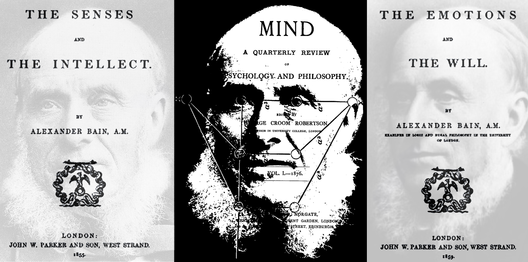Alexander Bain1818–1903
Bain wrote two textbooks on psychology that were to provide the prototypes for subsequent writers; in 1876 he also founded the first journal, Mind, concerned principally with psychological issues. Three portraits of him are shown, in the title pages of the books and the first issue of his journal. Bain integrated sensory physiology with philosophy to espouse an independent discipline of psychology “conceiving that the time has now come when many of the striking discoveries of Physiologists relative to the nervous system should find a recognised place in the Science of Mind”. He extended the union to higher mental processes and voluntary action, emphasising the importance of sensory feedback in the control of movement: “In treating of the Senses, besides recognising the so-called muscular sense as distinct from the five senses, I have thought proper to assign to Movement and the feelings of Movement a position preceding the Sensations of the senses; and have endeavoured to prove that the exercise of active energy originating in purely internal impulses, independent of the stimulus produced by outward impressions, is a primary fact of our constitution”. In stressing the motor component of perception he was the harbinger of behaviourism: “action is a more intimate and inseparable property of our constitution than any of our sensations, and in fact enters as a component part into every one of the senses.” He also appreciated those actions connected with the alleviation of pain or the increase of pleasure would occur with greater frequency. The Senses and the Intellect and The Emotions and the Will became the standard texts for psychology until the Principles of William James (1842-1910) appeared three decades later, and James drew upon them considerably. In addition to his texts on psychology Bain wrote books on english grammar, ethics, logic, rhetoric, and phrenology. He was born in Aberdeen, studied philosophy at Marischal College, Aberdeen, and taught moral and mental philosophy there for the next five years. He returned to Aberdeen University in 1860, as professor of logic and rhetoric, after a period in London lecturing and living off his pen. The central illustration reflects the importance of Bain’s Mind, which was initially edited by one of his former students, George Croom Robertson (1842-1892); it also incorporates a model of a neural processing designed by Bain to give differential output with input of varied intensities. That is, he proposed a connectionist account of learning: “I can suppose that, at first, each one of the circuits would affect all others indiscriminately; but that, in consequence of two of them being independently made active at the same moment (which is the fact in acquisition), a strengthened connexion or diminished obstruction would arise between these two, by a change wrought in the intervening cell-substance; and that, afterwards, the induction from one of these circuits would not be indiscriminate, but select; being comparatively strong towards one, and weaker towards the rest”. Over 70 years later the same principle was stated by Donald Olding Hebb (1904-1985) in ignorance of Bain’s model, and it is now known as Hebb’s rule!
